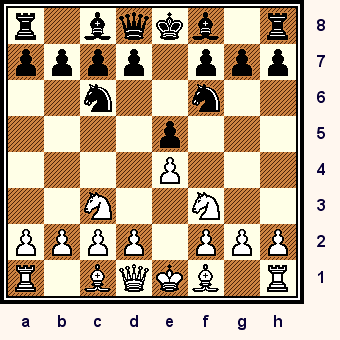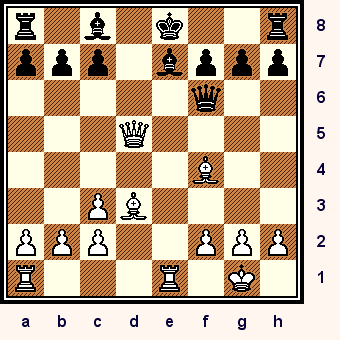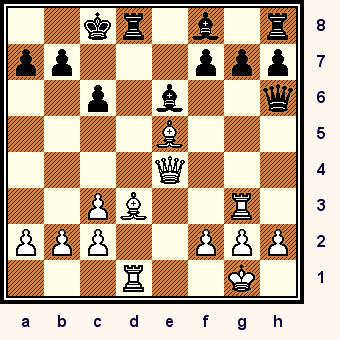All
the |
(Navigation bar
directly below.)
*******
© A.J. Goldsby, 2015.
(All rights reserved.)
****************
Click HERE
to see my
Chess Items.
****************
****************
Buy a book
from Amazon.com
(And help me out as well!)
****************
Click HERE
...
to see a list of the businesses that help to sponsor all of
my chess efforts.
A nice miniature by Edward Lasker!
I saw this game a long time ago ... I cannot even recall where.
When it was the problem of the day on another website ... I decided to annotate it.
Click HERE to see a detailed explanation of the symbols that I use when annotating a chess game.
Click HERE to replay this game on another website. (Source for the player's ratings.)
Edward Lasker (2470) - Fritz Englund
(2426)
|
|
|
An impressive effort by Ed Lasker.
1.e4
e5; 2.Nf3 Nc6; 3.Nc3 Nf6;
{See the diagram given below.}
The Four Knights Game.
***************************
|
|
****************************
r1bqkb1r/pppp1ppp/2n2n2/4p3/4P3/2N2N2/PPPP1PPP/R1BQKB1R w
While this was common to master level chess over 100 years ago, it is a very rare guest today.
(A happy exception was:
IM Boris Kreiman - GM Larry Christiansen;
The U.S. Championship Tournament
/ Seattle, WA / USA / 2002.
This was an extremely complicated draw ... in just under forty moves.
I deeply annotated this game for a game collection that I did, {a
few
years back};
if you are interested you can write
me and obtain a copy.)
4.Bb5,
The most commonly played move here for White.
(Probably also the best, even today.)
[
An interesting game ... that was also a miniature was:
4.Bc4!? Bc5; 5.d3 a6;
Play has now transposed to a very quiet line of the Giuoco Piano.
6.0-0 d6; 7.a3!? Nd4!?;
This could be an inferior move ... I played it mostly to get away
from all the book lines - and also it was an attempt to break the
symmetry. (My opponent stated that he had won dozens of games
from this position, so I did not want to become just another one
of his victims in this line!)
Now pinning (on g5) looks natural, but is actually going
astray
for White.
(>/= 8.Nxd4, exd4; 9.Ne2, 0-0; 10.Bg5,
"+/=" probably
gives White a small - but sure - advantage.)
8.Bg5?! h6!?; (Maybe - '!')
Playing ...Bg4! was also good for Black in this position.
(But I had something different in mind.)
Now White should exchange on f6.
9.Bh4? g5!; 10.Bg3 h5!!;
I immediately go for my opponent's King ...
he actually tried to talk me out of playing this move!!
(He even said he would not accept this move, and offered
a variation "proving" that White would win easily. I asked
him to be patient, humor me, and to please just play it out.)
11.Nxg5 h4!; 12.Nxf7 hxg3!!;
13.Nxd8 Bg4!;
14.Qd2!?, hmmm
This is too greedy and probably is an error. (Fritz shows
that the move of 14.Nxb7! was a much better defense
here for White.)
Believe it or not, my opponent asked (demanded?) that I
resign here ... and spare myself any more humiliation!!!!!
{I refused.}
( But definitely not: </= 14.f3? Nxf3+!; (double-check)
15.Kh1[] Rxh2# )
14...Nf3+!!; 15.gxf3 Bxf3;
16.Bf7+!? Kxd8;
17.h4 Rxh4;
0-1 {White cannot prevent a mate.}
R. Schinkmann -
A.J. Goldsby I;
Correspondence (e-mail) /
2001.
To be honest, I had seen another contest similar to this one
close to thirty years ago ... but it was still fun to play a game
like this!
Since I originally showed this game at the club - it also got
posted on another server ... ... ... but that is another story.]
4...Nd4!;
This is ... "The Rubinstein Defense," and was basically responsible for putting this opening out of business.
[
The move of: 4...Bb4!?;
"~" maintaining the symmetry ...
was also possible for Black. [See MCO-14, page # 119;
all columns and associated notes.]
]
5.Nxe5!?,
This leads to a lot of exchanges, and Black should be able to level the
playing field with exchanges. (Theory - today - considers this move to be relatively harmless.)
[ The best move for White on his fifth turn is generally
thought to be 5.Ba4. (Many books award this move
an exclamation point.)For example: >/= 5.Ba4! c6!?;
This is good, 5...Bc5 was also playable here for Black.
(See column # 12 for more information.)6.Nxe5 d6!; 7.Nf3 Bg4!;
Thus far, I was able to find around 75 games in the
database with this position. By far, the highest-rated
example would have to be:GM A. Motylev (2641) - GM A. Grischuk (2666);
The (FIDE) World Championships (k.o.) Tournament /
(Round #2) Moscow, RUS / 2001. (1-0, 39 moves.)We continue by following the variation found in one fairly
reliable (G.R.) opening manual:
8.d3 d5!; 9.Be3 Nxf3+!; 10.gxf3 Bh5; 11.Bd4!? dxe4!;
The end of the column.12.dxe4 Bxf3; 13.Qxf3 Qxd4; "="
This position is roughly equal, at least according to
GM Nick de Firmian.[ See MCO-14, page # 121; column # 10, and note # (o.). ] ]
5...Qe7!?;
(Blocks the Black KB.)
This move is both 'book' ... and also nearly forced for Black.
(To regain the lost Pawn.)
6.Nf3 Nxe4;
This was seemingly the only move for Black ... for over 30 years. But then E. Gruenfeld, (in a
correspondence
match with Wolf in 1919); showed the correct way to handle this position was to play 6...NxB/b5!; with good play for the second party.
[ A big improvement would be:
>/= 6...Nxb5!;
7.Nxb5 Qxe4+;
8.Qe2 Qxe2+;
9.Kxe2 Nd5;
10.Re1 a6; "=" {Diagram?}
& Black has probably equalized. (White is ahead in
development, but analysis shows
that Black should
be able to hold the balance.) ]
Now White gains a very large edge, with simple and straight-forward moves. Meanwhile, the second player is trading off all of his developed pieces.
7.0-0 Nxc3;
8.dxc3 Nxf3+;
9.Qxf3 Qc5; 10.Re1+ Be7;
11.Bd3!?,
This is good enough for a sizeable advantage for White. (Fritz
prefers another move ... I don't see that it makes that big a difference.)
[ Also good was: 11.a4, '±'
with a very large edge, (± or
+/-);
for White from this position. ]
11...d5;
12.Be3 Qd6!?;
13.Bf4 Qf6; 14.Qxd5,
"+/="
{See the diagram given below.}
Edward Lasker chooses to immediately regain the Pawn ...
to me, this is a perfectly natural move for White.
***************************
|
|
****************************
r1b1k2r/ppp1bppp/5q2/3Q4/5B2/2PB4/PPP2PPP/R3R1K1 b
White has a sizeable advantage here.
[ Also interesting was: 14.Qg3!?, with strong pressure. (Fritz 8.0) ]
14...c6!?;
Is this bad ... good ... or even forced for Black?
[ What happens if Black grabs the bait ...
the Bishop on the
f4-square?
14...Qxf4!?;
15.Bb5+! c6;
Looks forced, 15...Bd7?? was simply impossible.
16.Bxc6+!! bxc6!?;
{Box?}
Seemingly a blunder ... while Fritz seems to indicate
that this move is forced.
( But not: </= 16...Kf8?; ('??') 17.Qd8+! Bxd8; 18.Re8#. )
17.Qxc6+ Kf8;
18.Qxa8 Qc7;
19.Re2 g6; 20.Rae1, '±'
when White's Rook - and three Pawns - should be considered
(much) superior to Black's two Bishops.
]
15.Qe4 Be6;
16.Re3!? Bc5?!;
Castling (Q-side) was probably forced for Black in this position.
17.Be5 Qh6!?;
18.Rg3 Bf8!?;
Black is getting badly tied up.
(He is - also - already lost, so it may not matter, anyway.)
Now Fritz likes Qd4 here.
19.Rd1 0-0-0?;
{See the diagram given below.}
Today, missing this idea would be considered a blunder ... but close to one hundred years ago, the idea was not seen all that often.
***************************
|
|
****************************
2kr1b1r/pp3ppp/2p1b2q/4B3/4Q3/2PB2R1/PPP2PPP/3R2K1 w
Now White can win ... brilliantly.
[Better was: >/= 19...Rd8[]; - Fritz.]
It is Lasker's turn to move here.
20.Qxc6+! bxc6;
21.Ba6#.
A very attractive, decisive and beautiful miniature.
Copyright (c) A.J. Goldsby, 2005. All rights reserved.
1 - 0
The analysis - for this page - was created with the programs, ChessBase 8.0 and ChessBase 9.0.
The HTML was prepared with three different programs, and then polished with MS FrontPage.
The diagrams were prepared with the excellent little program, Chess Captor 2.25.
Click HERE to - go to or return - to my HOME PAGE ... for this site.
Click HERE to - go to or
return - to my page on miniatures / "Best Short Games."
(Or you could use the "Back Button" on your web
browser.)
Copyright (c) A.J. Goldsby I
Copyright (©) A.J. Goldsby, 2011. All rights reserved.
*******
This page was first created in November, 2005. It was last updated on 07/14/12 .


